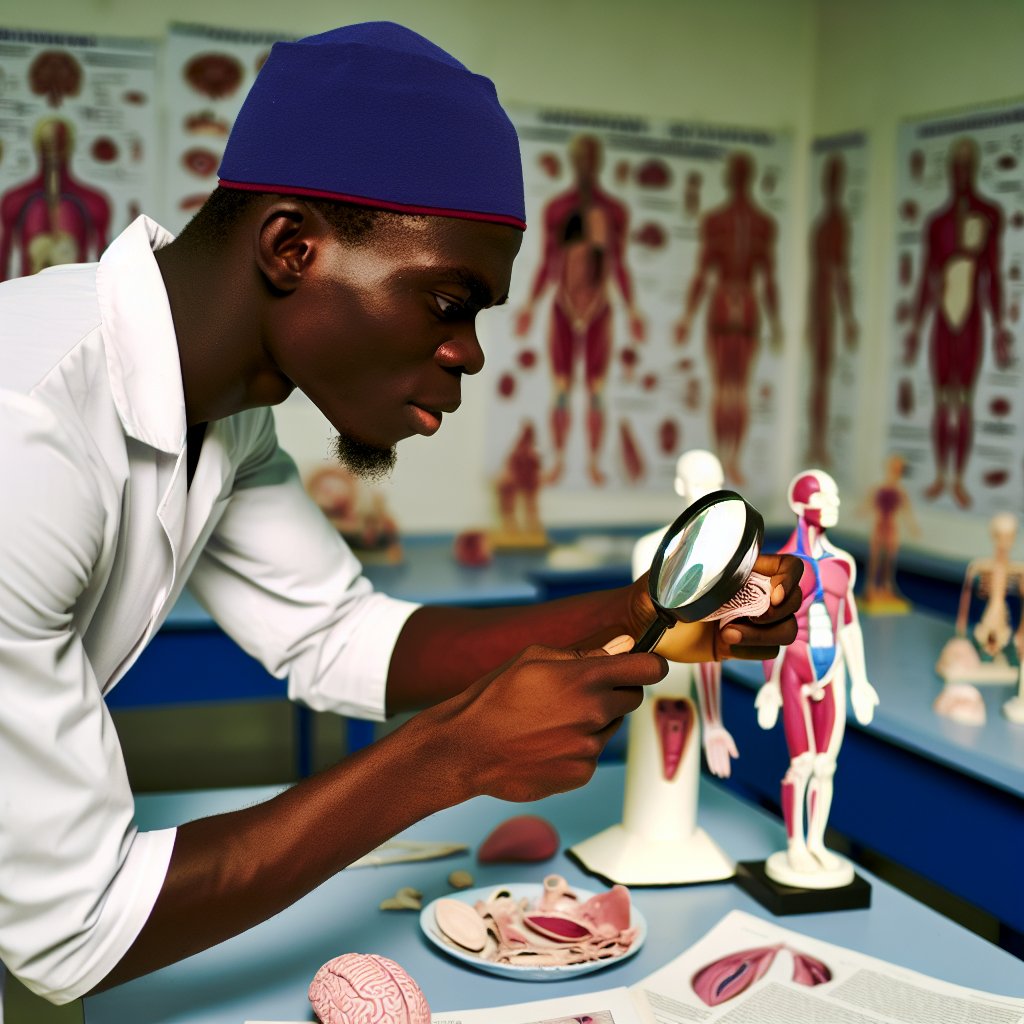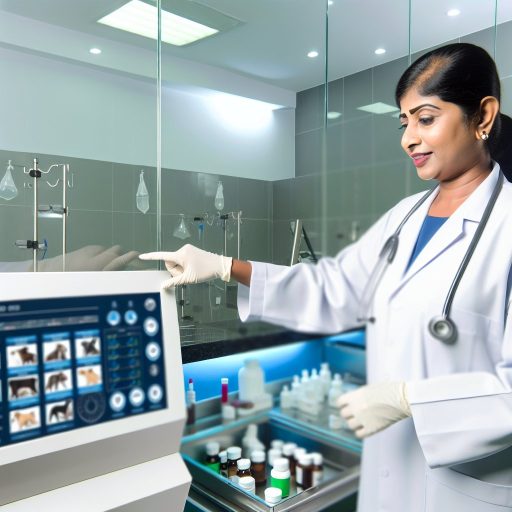Introduction
Anatomy is the study of the structure of living organisms.
An essential discipline in medical science.
Understanding human anatomy is crucial for medical professionals.
They need to provide accurate diagnoses and treatments.
The history of anatomy as a discipline in Nigeria dates back to the colonial era.
Medical education was introduced in the country during this time.
Pre-colonial era
In the pre-colonial era, the anatomy discipline in Nigeria was primarily based on traditional medical practices.
- Traditional medical practices involving anatomy knowledge
- Include using herbal medicine and surgery techniques
- Formal education in anatomy was limited during this period
Traditional healers played a significant role in providing healthcare to the people in various communities across Nigeria.
These healers had a deep understanding of anatomy, which was passed down through generations.
They utilized herbs and plants to treat ailments while also performing basic surgical procedures when necessary.
However, the knowledge of anatomy was mostly experiential and not based on formal education as seen today.
Colonial era
During the colonial era, there was a shift in the practice of anatomy in Nigeria with the arrival of European missionaries and colonialists.
- Introduction of Western medicine and anatomical practices
- Establishment of medical schools and hospitals
- Integration of traditional and modern medical practices
The Europeans brought with them new medical knowledge, including a deeper understanding of anatomy based on scientific principles.
They established medical schools and hospitals, which provided a formal education in anatomy for Nigerians who were interested in pursuing a career in medicine.
Despite the introduction of Western medicine, traditional practices continued to play a significant role in healthcare delivery, and there was a gradual integration of both systems.
Post-colonial era
After gaining independence, Nigeria saw a significant expansion in the field of anatomy and medical education.
- Establishment of more medical schools and research institutions
- Growth in the number of trained anatomists and healthcare professionals
- Advancements in medical technology and research in anatomy
The post-colonial era brought about a surge in the establishment of medical schools and research institutions across the country.
This led to an increase in the number of trained anatomists and healthcare professionals who played crucial roles in the healthcare system.
Advancements in medical technology and research in anatomy further propelled the discipline forward, leading to improved healthcare outcomes for the Nigerian population.
Current status
Today, anatomy as a discipline in Nigeria is thriving with a growing number of professionals dedicated to the study of the human body.
- Integration of traditional and modern anatomical practices
- Collaboration with international partners for research and training
- Ongoing efforts to improve medical education and healthcare delivery
Nigerian anatomists continue to blend traditional practices with modern anatomical knowledge, providing holistic healthcare to patients.
Collaboration with international partners has enabled Nigerian anatomists to engage in cutting-edge research and training programs.
Ongoing efforts to improve medical education and healthcare delivery will ensure that the anatomy discipline in Nigeria continues to grow and evolve in the future.
Colonial era
During the colonial era in Nigeria, the discipline of anatomy saw significant changes.
Western medical practices were introduced to the country.
The establishment of medical schools and training facilities played a crucial role in the development of anatomical knowledge.
Introduction of Western medical practices
The arrival of British colonial rulers in Nigeria brought along Western medical practices.
This included the study of anatomy.
This marked a shift in healthcare and medical education in the country.
Establishment of medical schools and training facilities
Several medical schools and training facilities were established across Nigeria.
These institutions provided a platform for the teaching and study of anatomy.
Influence of British colonial rulers on anatomy education in Nigeria
British colonial rulers played a significant role in shaping anatomy education in Nigeria.
They introduced modern medical practices and standards.
These included the study of anatomy in medical curricula.
The colonial era was a period of transformation for the discipline of anatomy in Nigeria.
The influence of British colonial rulers led to the introduction of Western medical practices.
Medical schools were established, and there was a focus on anatomy education in the country.
See Related Content: Life After Medical School: Career Paths in Nigeria
Post-independence era
In the post-independence era, Nigeria experienced a significant expansion in medical education.
This had a direct impact on the anatomy discipline.
Transform Your Career with Expert Guidance
Get personalized mentorship consulting that’s tailored to your unique path. Our expert advice is actionable and exclusive.
Get StartedThe country witnessed an increase in the number of medical schools.
This contributed to the growth and development of anatomy as a field of study.
Expansion of medical education in Nigeria
With the establishment of new medical schools across the country, more opportunities were created for students to pursue a career in medicine.
This expansion also led to an increased demand for qualified anatomy instructors and researchers.
The growth of medical education in Nigeria attracted foreign experts and researchers.
This further enriched the field of anatomy with diverse perspectives and expertise.
Collaborations between local and international professionals helped to enhance the quality of research and education in anatomy.
Increase in anatomy research and publications
As the number of medical schools and research institutions grew, there was a corresponding increase in anatomy research and publications in Nigeria.
Local researchers began to focus on issues that were relevant to the country’s healthcare system and population.
Studies on anatomy became more specialized.
Researchers delved into various sub-disciplines such as neuroanatomy, histology, and embryology.
This specialization led to a deeper understanding of the human body and its functions.
It contributed to advancements in medical practice.
Role of Nigerian medical professionals in advancing anatomy discipline
Nigerian medical professionals played a crucial role in advancing the anatomy discipline in the post-independence era.
Many doctors and researchers dedicated their careers to studying anatomy.
They conducted research and published their findings in local and international journals.
These professionals not only contributed to the body of knowledge in anatomy but also trained the next generation of medical students.
Their expertise and dedication helped to elevate the status of anatomy as a respected and essential field within the medical community in Nigeria.
Gain More Insights: Accessing Obstetric Care in Rural Nigeria
Challenges Facing Anatomy Education in Nigeria
In Nigeria, the discipline of anatomy has faced numerous challenges over the years.
These challenges have hindered the growth and development of anatomy education in the country.
Limited Resources and Funding for Anatomy Education
One of the major challenges faced by anatomy departments in Nigeria is the lack of adequate resources and funding.
This has resulted in a shortage of modern equipment, teaching materials, and facilities needed to provide quality education in anatomy.
The limited resources have also impacted research activities in anatomy.
This situation makes it difficult for researchers to carry out groundbreaking studies that could contribute to the advancement of the field.
Lack of Specialized Training Facilities
Another challenge faced by anatomy departments in Nigeria is the lack of specialized training facilities.
Many schools lack cadaveric dissection labs, histology labs, and other essential facilities for hands-on learning.
Without access to these specialized training facilities, students may not receive the practical experience necessary to fully understand anatomical concepts and principles.
Brain Drain of Skilled Anatomists to Other Countries
Nigeria has experienced a brain drain of skilled anatomists to other countries in search of better opportunities and working conditions.
This has led to a shortage of experienced and qualified anatomy educators in the country.
The brain drain also means that Nigeria is losing valuable expertise in the field of anatomy.
This lost expertise could have been utilized to improve the quality of education and research in the discipline.
Find Out More: Specializations in Veterinary Medicine in Nigeria

Recent developments
- Improvement in anatomy curriculum in Nigerian universities
- Collaboration with international organizations for research
- Modernization of anatomy technology and teaching methods
Over the years, there have been significant advancements in the field of anatomy in Nigeria.
These developments have brought about positive changes in the teaching and practice of anatomy in the country.
Improvement in anatomy curriculum in Nigerian universities
One of the major recent developments in the anatomy discipline in Nigeria is the improvement in the anatomy curriculum in universities across the country.
This improvement has been aimed at aligning the curriculum with international standards and modern practices in the field.
The updated curriculum now includes more hands-on practical sessions, research opportunities, and interdisciplinary collaborations with other healthcare disciplines.
This has enhanced the overall learning experience for students and better prepared them for future careers in anatomy-related fields.
Furthermore, the revised curriculum incorporates the latest advancements in anatomical sciences, such as the use of cutting-edge technologies like virtual dissection software and 3D modeling.
This has not only improved the quality of education but also made learning anatomy more engaging and interactive for students.
Collaboration with international organizations for research
Another significant development in the anatomy discipline in Nigeria is the increased collaboration with international organizations for research purposes.
These partnerships have allowed Nigerian anatomists to engage in cutting-edge research projects, exchange knowledge and expertise, and collaborate on publications and conferences.
By working with international organizations, Nigerian anatomists have been able to access resources and funding that may not have been available otherwise.
This has led to the publication of research papers in top-tier journals, presentations at international conferences, and the establishment of global networks in the field of anatomy.
Furthermore, these collaborations have facilitated the exchange of ideas and best practices, leading to the adoption of innovative research techniques and methodologies in Nigerian anatomy departments.
This has not only elevated the quality of research being conducted but has also put Nigerian anatomists on the map in the global scientific community.
Modernization of anatomy technology and teaching methods
One of the most noticeable recent developments in the anatomy discipline in Nigeria is the modernization of anatomy technology and teaching methods.
Advances in technology have revolutionized the way anatomy is taught and practiced in the country.
State-of-the-art anatomy labs equipped with virtual dissection software, 3D printing capabilities, and advanced imaging techniques have been established in many Nigerian universities.
These modern facilities have enhanced the learning experience for students by providing them with hands-on experience and exposure to cutting-edge technologies used in anatomical research and practice.
In addition, innovative teaching methods such as flipped classrooms, problem-based learning, and active learning strategies have been adopted to make anatomy education more interactive and engaging.
These methods have been found to improve student retention, understanding, and critical thinking skills, ultimately leading to a more well-rounded education in anatomy.
See Related Content: Medical Rehabilitation Workshops and Seminars Nigeria
Contributions to healthcare
Anatomy in Nigeria has played a crucial role in advancing healthcare through research and education.
Importance of anatomy in medical diagnosis and treatment
Anatomy provides the foundational knowledge for understanding the structure of the human body.
This knowledge is vital for accurate diagnosis and treatment.
Training of healthcare professionals in anatomy
Nigerian medical schools prioritize anatomy education.
This ensures that healthcare professionals have a solid understanding of the human body.
Impact of Nigerian anatomists on global medical research
Nigerian anatomists have made significant contributions to global medical research.
These contributions are particularly evident in areas such as anatomy education and anatomical sciences.
Anatomy Education Progress in Nigeria
Summarily, the history of anatomy discipline in Nigeria has seen significant growth over the years.
The progress made in anatomy education is commendable.
It is essential to continue supporting and advancing the anatomy discipline in Nigeria to ensure excellence in medical education and research.
Additional Resources
Anatomy Education in Nigeria: An Empirical Study of Students …
Thirty-five years (1986–2021) of HIV/AIDS in Nigeria: bibliometric …




